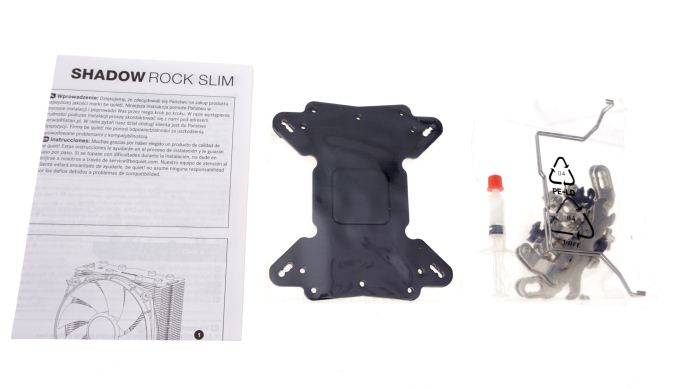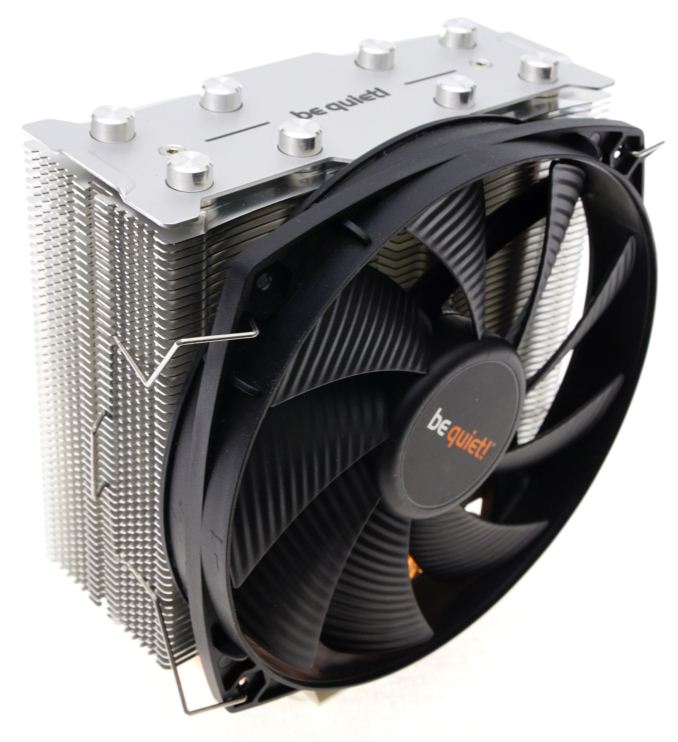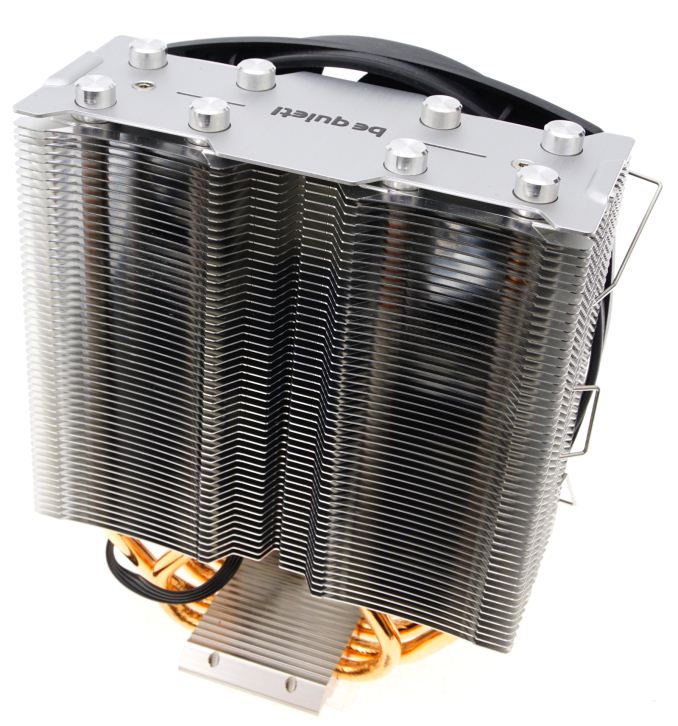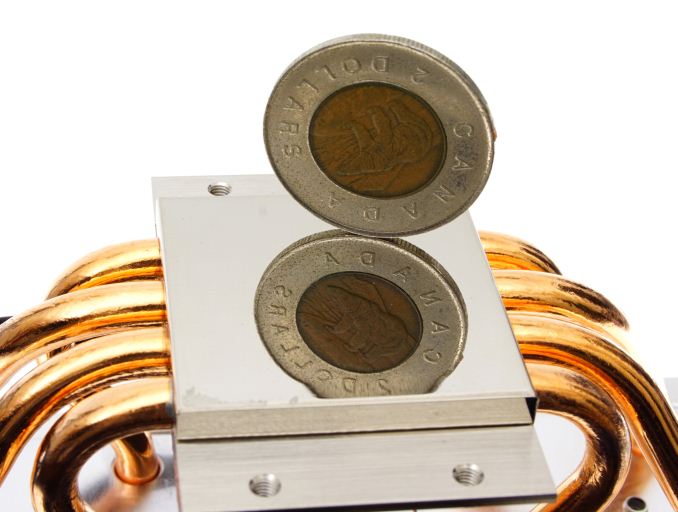The 140mm Slim Tower CPU Cooler Roundup: Thin & Light Done Just Right
by E. Fylladitakis on May 24, 2017 8:00 AM EST- Posted in
- Cases/Cooling/PSUs
- be quiet!
- Noctua
- Phanteks
- Cooler
- Thermalright
Be Quiet! Shadow Rock Slim
Be Quiet supplies their tower cooler in a black, sturdy cardboard box, with minimal artwork but plenty of information about the cooler printed on all sides of the box. The company straightforwardly advertises that this cooler is capable of handling CPUs with thermal design power (TDP) up to 160 Watts, but this figure alone does not tell much about the overall performance of a cooler.
Inside the box we found a frugal bundle, consisting of a one-fits-all backplate, mounting hardware, a syringe with thermal compound, and a leaflet with very basic installation instructions.
The Shadow Rock Slim initially appears to be a very simple tower cooler that has been designed for 140 mm cooling fans. A closer inspection however reveals a very complex fin cutout that has been developed so as to minimize aerodynamic drag and, in extend, the noise that is being created by the moving airflow. A thicker, decorative metallic plate with the company logo etched on it can be seen at the top of the fin array. Rounded metallic caps cover the heatpipe end points.
Despite its “slim” identification, the Shadow Rock Slim is not really a slim CPU cooler. It certainly is much smaller than the monstrous Dark Rock Pro 3 that we reviewed a couple of years back, but still the body of the cooler alone is 52 mm wide. It comes with one of the company’s better fans, a special 135 mm variation of their “SilentWings” series. These fans feature a rifle bearing engine, which greatly improves the lifetime of the fan relative to the typical sleeve bearings, all the while retaining similar low-noise operation characteristics.
The Shadow Rock Slim is designed with only four heatpipes and a slightly smaller base than that of the other coolers in this review. Its design is sound, with the two middle heatpipes that will be facing the bulk of the thermal energy flow expanding into the edges of the fin array, where the airflow is going to be greater. This is the only cooler of this review that does not have nickel-plated heatpipes, so we can expect that their vibrant polish will soon disappear due to oxidation. (Oxidation doesn't cause any real damage, but it does eventually affect the cooler’s aesthetics)
The lower half of the cooler’s base is also made out of copper but, unlike the heatpipes, it is nickel plated. It has also been polished down to an immaculate mirror finish. The top half of the base is solid aluminum and does look like a small heatsink, yet its contribution to the overall performance of the cooler will be negligible, it is only meant to provide mechanical cohesion and support for the mounting hardware.
















74 Comments
View All Comments
Yuriman - Wednesday, May 24, 2017 - link
Nice review! Please do more of these.One thing I'd like to see is to have the coolers' thermal resistance normalized for noise. I understand that's not an easy task, but it would be nice to see how much each can dissipate at a given noise level (the only two metrics most people really care about), rather than having both noise and resistance being variables.
Paapaa125 - Wednesday, May 24, 2017 - link
I agree, that would be the best data. If not feasible, I'd like to see the thermal characteristics of each cooler using the same fan at the same speed (tested at many levels).Lolimaster - Thursday, May 25, 2017 - link
Ryzen 7 1700 + Hyper 212X <45°C at load @900rpm, can't even hear the thing.fanofanand - Thursday, May 25, 2017 - link
There are way more variables loli, what kind of case do you have? Any added insulation? What's the average sound level in your room? Do you have a high powered GPU that drowns out the CPU cooler? Do you have loud case fans? Do you have a loud PSU? I'm sure you have a very nice system so having a normalized test would clear up the questions for everyone rather than anecdotal "I can't hear it" statements. Not trying to attack what you are saying but I 3rd the idea that normalized testing for performance at a specific sound level would be great. Even then, different sounds can be more grating than others depending on the pitch. This is probably the hardest area of computing to test, is sound.Lolimaster - Saturday, May 27, 2017 - link
Cheapo case, only fans are the cpu, psu (a seasonic) and a RX560 a low rpm + undervolt.The only thing I actually hear are my 3 HDD's, if I boot without those is basically the expected electric hum.
My place is quite silent.
Gigaplex - Monday, May 29, 2017 - link
If you can't hear the Hyper 212X @900rpm you may need to get your ears checked.JocPro - Monday, May 29, 2017 - link
Same here, R7 1700 + Thermaltake NiC L32 (It's a Slim 140mm tower - why wasn't in the review?) 500 RPM idle, ~600 RPM load... I can't hear it, even trying. The case has 4 CM Silencio PWM @ 900 RPM, and only the air pushed is audible.jospoortvliet - Friday, May 26, 2017 - link
I would prefer to see coolers sped up to the point they produce a fixed amount of noise (say 38db or so) and then compare how much they cool. A much better way to compare them.Robotire - Wednesday, May 24, 2017 - link
Interesting topic but I have a hard time getting useful information out of this article. I would have prefered to see noise levels and efficiency at idle and at full CPU load instead of these artificial 7V and 12V levels. Also there is no easy to read conclusion to help people in a hurry choose the best cooler for their need, and I have no idea what the thermal resistance values mean.mgilbert - Wednesday, May 24, 2017 - link
When it comes to air coolers, there's Noctua, then there is everyone else. They are superior in virtually every respect, especially quality and support.